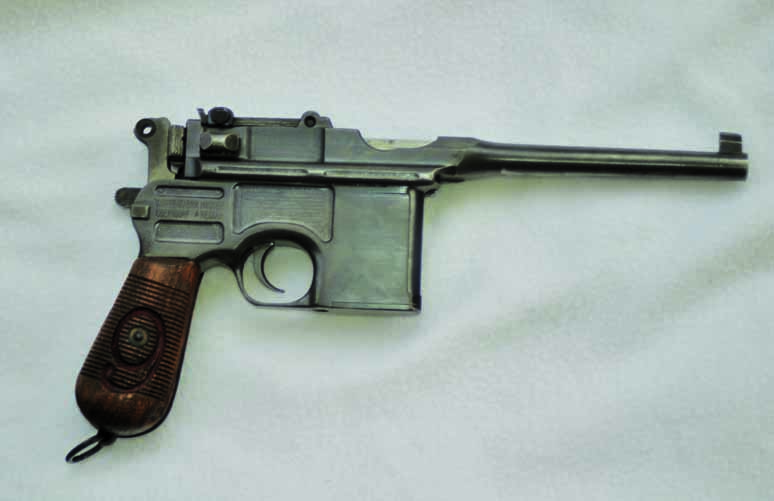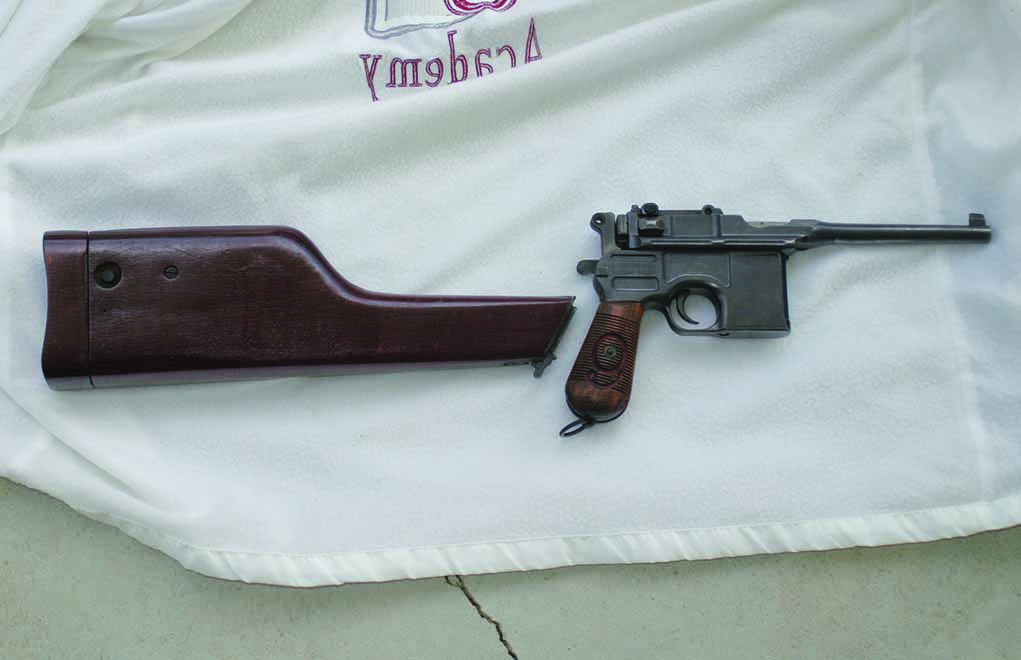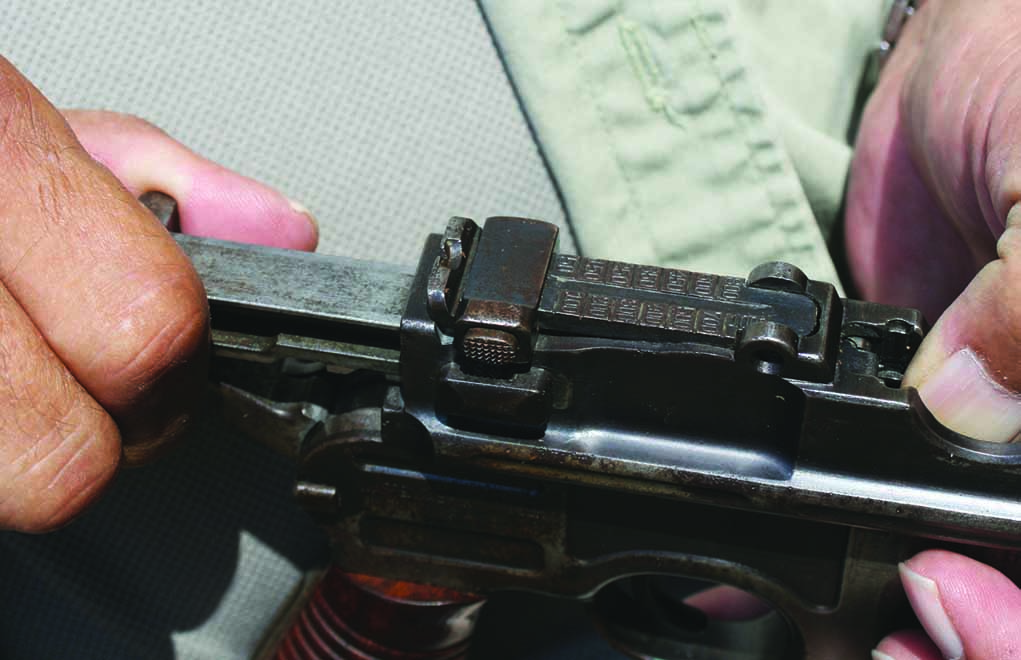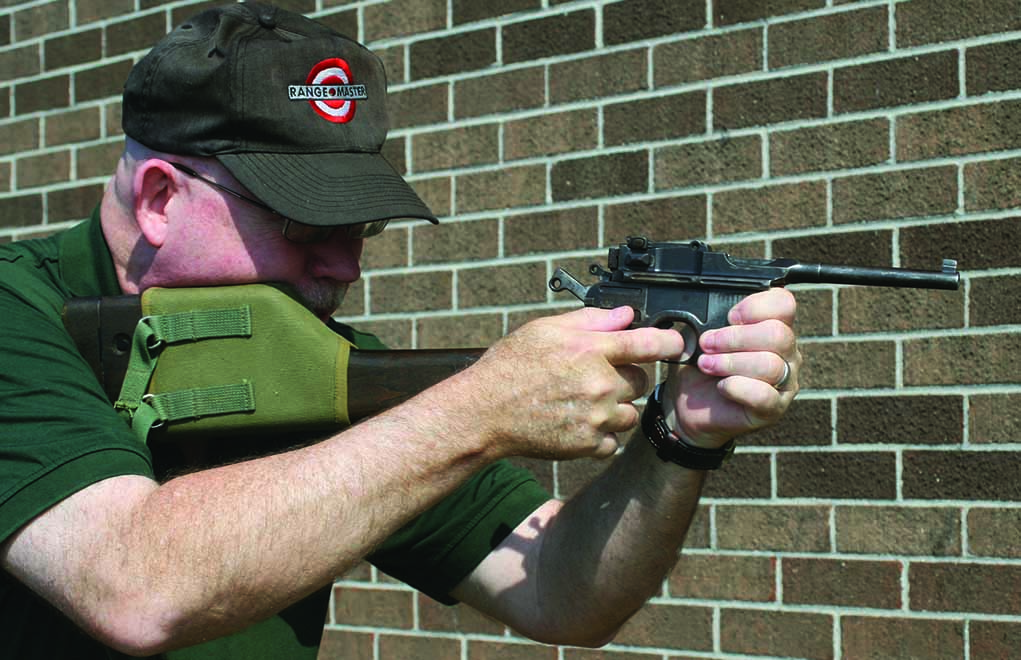

The landmark Mauser C96 design changed things in a dimension far beyond the world of the pistol and still looms large in the mind today.
Why The Mauser C96 Still Looms Large:
- Considered the first truly successful semi-auto pistol.
- Operated through a short-recoil, locked-breech mechanism.
- Awkward grip-shape gave it the nickname “broomhandle.”
- Loaded via a stripper clip.
- Tangent sights supposedly could be adjusted for accurate fire at hundreds of meters.
- A detachable buttstock was available, converting the pistol into a carbine.
The C96 pistol is one of the most recognizable handguns ever made. Its integral magazine, loaded via stripper clips, sat ahead of the trigger guard, and its rather awkward grip-shape gave it the nickname “broomhandle.” The C96 was the first military semiautomatic pistol to prove itself both rugged enough and reliable enough for field use, though its substantial size and a shape not conducive to concealment would limit its appeal as a “personal gun.” Its stripper clip loading mechanism would never be as fast to reload as a semiautomatic with removable box magazines, particularly if the design encompassed the thumb button magazine release popularized by the Luger of 1902.
Many of these Mauser pistols left the factory with tangent sights that could supposedly be adjusted for accurate fire at hundreds of meters. That proved to be rather over-optimistic. However, the Mauser was a far-reaching weapon in a much more important way. It was a harbinger of things to come, of the profound changes in battle tactics and technology that would take place in the 20th century.
A brief history Of The Mauser Pistol
Completed in prototype in the year 1895, patented in 1896, and coming off the production line in 1897, this pistol would be produced by Mauser until the late 1930s. It was the first truly successful semiautomatic pistol. The design is credited to three brothers: Fidel, Friedrich, and Josef Feederle.

Patented with a spur-shaped hammer, the gun would be produced primarily with a ring-shaped hammer, and for a time early in its epoch with a “coned” hammer. This had extensions that tapered out to the sides, intended to give better traction to the shooter’s thumb, rather like the hammer spur attachments found on modern lever action rifles that have been mounted with telescopic sights.
Built with a short-recoil, locked breech mechanism, the C96 loads with stripper clips through the top of the mechanism’s ejection port. The rectangular bolt enclosed in its receiver or frame is locked back during this procedure. A rearward tug on the bolt then chambers the topmost cartridge. While awkward and cumbersome by today’s standards, the Mauser C96 design represented a quantum leap forward in handgun reloading speed in the late 19th century.
Its integral magazine machined into the gun forward of the trigger guard, the magazine’s housing normally extended down level with the bottom of the trigger guard. It rode higher, almost to the top edge of the trigger guard, on the rare and short-lived compact model that did not survive into the 20th century; this model held only six cartridges. Still rare, though not as much so, were the later machine pistol variations with detachable, extended magazines that reached down almost parallel with the butt of the gun.

There were long gun versions, notably the Kavallerie Karabiner (cavalry carbine, complete with a wooden fore-end that extended from the magazine to well out under the barrel). Far more popular, however, was the detachable buttstock fitted to a C96 pistol with standard length barrel. This was made of wood, of course, and was cleverly hollowed out to also be a combination holster and storage box for the pistol itself, attaching to the rear of the grip frame and turning the pistol into a light, handy, short-barreled carbine. An ad for the gun, circa 1900, promised: “The Pistol is provided with a Walnut Butt Stock instantly attachable by a sliding tennon and spring catch to the back of the Grip.(sic) When not in use as a stock this Butt serves as a Holster its interior being hollowed out to the shape of the Pistol whose Grip projects about half its length outside to facilitate quick drawing.”
Take Aim At Classic Guns:
- Is A Mosin-Nagant Still Worth The Money?
- M1 Garand: America’s Original Battle Rifle
- Browning A5 Shotgun: The First Autoloader
- Colt Detective Special: As American As The Second Amendment
- Winchester Model 1897 Pump-Action Shotgun
Over a span of some 40 years, Mauser produced approximately a million of these pistols. A very significant quantity of Mauser C96 copies were produced in Spain, mostly under the Astra and Royal marques, the latter produced by Beistegui Hermanos. In China, this pistol was adopted by military and police alike, and became hugely popular when the 1919 Arms Embargo Agreement stopped the import of battle rifles into that country. A loophole left shoulder-stocked pistols exempt, and Chinese warlords bought them in vast numbers. It was this market that led to the rise of the Spanish clones, and of China’s own indigenous copies, the best generally recognized to be those from the Shanxi Arsenal and Hanyang Munitions Works.
The original caliber would be the most popular: 7.63X25mm Mauser, known at the time as simply 7.63mm Mauser. It sent a full metal jacket bullet weighing 86 grains downrange at a then-awesome velocity of 1450 feet per second, generating 402 foot-pounds of energy at the muzzle.

They would also be produced in significant numbers in 9mm Parabellum, and in small quantities for a proprietary cartridge called the 9mm Mauser Export. This was simply the bottlenecked 7.63mm Mauser case blown out to straight-wall dimensions to take a 9mm bullet. The People’s Republic of China would eventually manufacture a clone chambered for the 7.62X25 Tokarev round. In China, the Shanxi Arsenal made oversize Mauser C96 clones chambered for the American .45 ACP cartridge, for commonality with the Thompson submachine guns that were then extremely popular in that land. Finally, Mauser briefly tried a proprietary cartridge, designated 8.15 mm, but it never got past the experimental stage.
The experimental cartridge was part of a fascinating chapter in the history of the broomhandle Mauser. After the Treaty of Versailles, ownership of firearms in military calibers was banned by the Weimar Republic. Oddly enough, 7.63mm Mauser was not considered a prohibited caliber, but 9mm Luger was. Mausers in 9mm Parabellum had to be altered to use an approved caliber, and stamped with the legend “1920,” thus creating a collectible category of C96 pistols that became known as M1920 Reworks. Most were re-barreled to 7.63mm Mauser, and some to .30 Luger, but at least one specimen – pictured here – received the “1920” stamp but remained chambered for 9mm Parabellum. (It also retained its standard 5.5-inch barrel length, despite the fact that the rule permitted nothing longer than a 4-inch barrel, which was coincidental with the introduction of the 3.9-inch Bolo Mauser.)
One of the most famous variations of this pistol is the Schnellfeuer (fast-fire), a machine pistol with fully automatic capability. Ironically, this was a case of “imitating the imitator.” It is widely believed among firearms historians that it was the Spanish clone-makers who first came up with selective-fire copies of the C96 for the Chinese market, and that Mauser introduced their version in response, even though Mauser had earlier developed full-auto models but not put them on the market. These were the Mausers with extended and removable magazines, the release button being ergonomically placed just above and ahead of the trigger guard for easy access by the shooter’s (right) trigger finger. The selector switch also seems to have been more ergonomically placed on the Mauser Schnellfeuer than on the Spanish machine pistols.

Within the scope of this book, there simply isn’t room to touch on all the vast number of Mauser C96 variations within a forty-year production run of a million pistols. For a short overview, the Wikipedia entry on the Mauser C96 seems complete and correct at this writing. For a deeper perspective, the reader is referred to The Broomhandle Mauser Pistol 1896-1936 by Erickson and Pate, The Mauser Self-Loading Pistol by Belford and Dunlap, and System Mauser by Breathed and Shroeder.
Shooting the C96
I know of no shooting championship ever won with the Model 96, but that was never part of its design parameters. My old and much mourned friend, the late Dean Grennell, once wrote of his personal C96, “Neither impressively accurate nor reliable in comparison to several other auto pistols, it had a most disconcerting habit of letting off two or three (shots) together, now and then.”1 The great handgun historian Geoffrey Boothroyd would write, “To modern eyes, the Mauser pistol is rather clumsy, complicated, and by no means easy to shoot without the shoulder stock attachment.

On the other hand, it is beautifully made to an extremely high standard, and a delightful pistol to own even if only for the pleasure of dismantling and the subsequent feeling of astonishment at the ingenuity with which it has been constructed. It was also the first pistol to incorporate a feature now considered essential, a hold-open device to ensure that the breech remains open after the last cartridge has been fired.”2
The Pistol's Pedigree
For most, the C96 is a pistol of history and of fiction. Its ungainly shape and slow-to-reload mechanism had rendered it obsolete as a service handgun long before Mauser discontinued it. Movie directors loved it for its exotic, sinister looks. Frank Sinatra wielded a shoulder-stocked version in the movie “The Naked Runner,” and George Lucas and his prop crew kitted out Harrison Ford’s Han Solo character with a broomhandle Mauser reshaped into his space gun “blaster” in the Star Wars movies. This pistol is the one which fans of Sax Rohmer novels would expect the evil genius Dr. Fu Manchu to draw from beneath his silken robes.
Yet, the gun was very real. Fairbairn and Sykes, the revolutionary combat pistol trainers for the Shanghai police in the 1920s, noted that the C96 was popular with the Chinese underworld and much feared by law enforcement. Its high velocity 7.63mm bullet tended to cause hideous wounds when it struck bone and shattered it into secondary missiles coursing out of the wound path in the victim’s body.

In WWI, 150,000 Mauser 96s were ordered by the Imperial German Army to supplement the Luger pistol. It had become abundantly clear that, in trench warfare, a handgun was a vital tool of close-quarter survival. These guns were chambered for the 9mm Luger cartridge. To help assure that they wouldn’t be mistakenly loaded with the original 7.63 mm. Mauser ammunition, these particular C96s were produced with a huge, crimson-color numeral “9” on each side of the wooden grips. They would become known as “Red Nine Mausers,” and dubbed by some collectors the 1916 Prussian model. The German contract for the supplemental Mausers was a stark parallel to United States orders for heavy frame Colt and Smith & Wesson Model 1917 revolvers during the same period to augment the Colt 1911 semiautomatic pistol, which also couldn’t be manufactured in enough volume to outfit every combat soldier on the line.
Indeed, the German military used these guns through WWII. Almost 8,000 C96s, the M30 commercial grade, were reportedly furnished to the Luftwaffe and proofmarked by the Wehrmacht. These were produced from the early 1930s to no later than 1940.
The C96 saw extensive use in the Spanish Civil War, and was a favorite of Chinese warlords. China was so taken with these guns that they couldn’t get enough Mausers, giving rise to Spanish-made and eventually Chinese-made copies.
Many refer to the C96 as the “Bolo Mauser” as if this was as generic a nickname for it as “broomhandle.” Not so; the term “Bolo” was short for Bolshevik. After the Bolsheviks took over Russia, they ordered large quantities of a C96 variant produced from 1920 to 1921, which featured smaller grips and a handy 3.9-inch barrel. This was the true Bolo Mauser. However, when we think of famous people who used this gun in real life, one name stands out conspicuously above all others…Sir Winston Churchill.
Editor's Note: This article originally appeared in the available at GunDigestStore.com.

Next Step: Get your FREE Printable Target Pack
Enhance your shooting precision with our 62 MOA Targets, perfect for rifles and handguns. Crafted in collaboration with Storm Tactical for accuracy and versatility.
Subscribe to the Gun Digest email newsletter and get your downloadable target pack sent straight to your inbox. Stay updated with the latest firearms info in the industry.

![Best Concealed Carry Guns In 2025 [Field Tested] Wilson Combat EDC X9S 1](https://gundigest.com/wp-content/uploads/Wilson-Combat-EDC-X9S-1-324x160.jpg)


![Best 9mm Carbine: Affordable PCCs [Tested] Ruger Carbine Shooting](https://gundigest.com/wp-content/uploads/Ruger-Carbine-Shooting-100x70.jpg)
![Best AR-15: Top Options Available Today [Field Tested] Harrington and Richardson PSA XM177E2 feature](https://gundigest.com/wp-content/uploads/Harrington-and-Richardson-PSA-XM177E2-feature-100x70.jpg)

Lawrence of Arabia was another famous individual who carried a C96.
One thing Massad overlooked and that was the deadly .30 Mauser Cartridge. Its high velocity killed way out of proportion to its size. In Massillon , Ohio several years ago an unfortunate police killing resulted when an over aggressive cop teed off an unbalanced motorist who shot him in the buttocks as he walked back to his patrol car. The cartridge was actually the .30 Tokarev an exact duplicate of the .30 Mauser and the bullet glanced upwards when it hit the officer in the buttocks tumbling and wiping out his internal organs killing him instantly. It was a fjm round.
I might add that during WWII during Mao Zedong’s “Long March” to Russia to escape the Nationalist forces pursuing him found a force blocking his retreat on the other side of a bridge. Communist Chinese troops found the bridge blown up but the guide ropes still in place. They went hand over hand over the ropes with Mauser Broom Handle pistols tucked into their tunics and wiped out several machine gun nests enabling Mao to resume his retreat and escape.